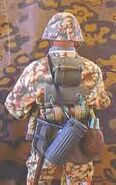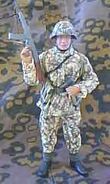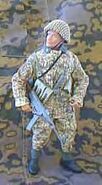The M45 is a battledress of German origin.[3][4][5][6][7][8][9][10][11][12][13][14][15][16][17]
Overview[]
The M45 is the last battledress developed and produced by Nazi Germany. It was based on the M44 uniform, however, due to economic restraints, it was of lower quality with a worse cut and the waist band of the M44 is absent. The uniform was printed in Leibermuster camouflage pattern and was intended to replace all of the previous camouflaged uniforms of both the Wehrmacht and the Waffen-SS.
The fabric had light-absorbing properties in the infrared spectrum, due to the use of Aniline black dye, in order to counter observation by early night vision devices that were coming into service just before the end of World War II. The Leibermuster is a six-colour design, comprising a buff background, white flecks overprinted with light green, overprinted with feathered, leaf-shaped medium green and red-brown swathes, overprinted with carbon black 'branches'. The new pattern was designed to maintain its disruptive qualities also at short distances. In contrast to the older German camouflage patterns that were printed on rollers of the same circumference, rollers of varying sizes were used with the aim of eliminating conspicuous pattern repeats.
The Leibermuster pattern is atributed to have been developed by Professor Schick, who is also credited for creating the earliest SS camouflage patterns, although this claim is by no means certain. Most of the information that is known about the M45 uniform was recorded by the U.S. Army Quartermaster Francis S. Richardson, who, on 20 July 1945, prepared a report on German camouflage for the U.S. Army. In his report, Richardson describes, at length, the time-consuming process that was needed, to produce Leibermuster cloth. He also observes that the pattern was primarily intended for the manufacture of Wintertarnanzug ('winter camouflage suits') and Zeltbahnen ('shelter quarters'), and that very few German soldiers seem ever to have been issued with these items. The pattern was introduced far too late to be issued in significant quantity. The Richardson report states that the printing factories did not receive any information on the new pattern until 15 January 1945. The M45 uniform was mostly issued to Wehrmacht soldiers on the Eastern Front, more specifically in Czechoslovakia from February 1945, however, there are reports of Leibermuster being used by SS foreign volunteer units in the Baltic, specifically while retreating in the Riga area.
Most surviving examples of the Leibermuster camouflage pattern are extremely faded and worn; this is perhaps because they were the only clothing available to German prisoners of war during their extended detention. Examples of surviving garments can be seen in "Waffen SS Camouflage Uniforms & Post-War Derivatives" by Daniel Peterson and "Camouflage Uniforms of the Waffen-SS - A Photographic Reference" by Beaver and Borsarello.
Variants & components[]
- Feldbluse (in M45 cut)
- Keilhosen
Gallery[]
In popular culture[]
|
Media |
Notes |
Date |
|---|---|---|
| Tank Brigade | Possibly the first appearance of M45 in media[19] | 1955 |
| Fury | Seen among the props for the film[20] | 2014 |
| Heroes & Generals | Available as a customization camouflage[21] | 2016 |
| Call of Duty: WWII | Available as a weapon camouflage[22] | 2017 |
References[]
- ↑ http://america.pink/leibermuster_2574261.html
- ↑ http://www.wehrmacht-awards.com/forums/showthread.php?t=285238&page=18
- ↑ http://www.panzergrenadier.net/forum/viewtopic.php?f=24&t=21201&start=15
- ↑ http://www.royaltigergear.com/product_info.php?products_id=1680
- ↑ http://www.armorama.com/modules.php?op=modload&name=SquawkBox&file=index&req=viewtopic&topic_id=206566
- ↑ http://m43connoisseur.blogspot.bg/2011_03_01_archive.html
- ↑ http://forum.valka.cz/topic/view/41140/2-sv-vojna-Leibermuster-M45
- ↑ http://www.wehrmacht-awards.com/Forums/printthread.php?t=524063&pp=40
- ↑ http://forum.axishistory.com/viewtopic.php?t=138579
- ↑ https://archive.is/rfvgC
- ↑ http://forum.axishistory.com/viewtopic.php?t=34406
- ↑ http://community.battlefront.com/topic/106914-camo-for-ss-units/
- ↑ http://www.feldgrau.net/forum/viewtopic.php?t=3845
- ↑ http://www.wehrmacht-awards.com/forums/showthread.php?t=20408
- ↑ http://www.warrelics.eu/forum/ss-uniforms-insignia/ss-m44-dot-camo-tunic-some-info-571685-2/
- ↑ http://wargamesobsession.blogspot.bg/search/label/Uniform
- ↑ https://forum.axishistory.com/viewtopic.php?t=60870
- ↑ http://discaircraft.greyfalcon.us/Little%20Known.htm
- ↑ http://wehrmacht-awards.com/forums/showthread.php?t=905385&page=4
- ↑ http://www.panzergrenadier.net/forum/viewtopic.php?f=24&t=21547&start=15
- ↑ https://heroesandgenerals.gamepedia.com/Camouflage
- ↑ http://callofduty.wikia.com/wiki/Leibermuster_Camouflage

![Nip4.jpg (28 KB) A hypothetical model reconstruction of 1946 Nazi German trooper with STG45 and M45 Stahlhelm with Leibermuster cover and smock. Note that neither helmet covers nor smocks were produced in this camouflage in reality[18]](https://static.wikia.nocookie.net/equipment/images/8/8f/Nip4.jpg/revision/latest/scale-to-width-down/185?cb=20180102151341)


